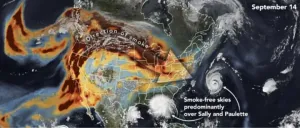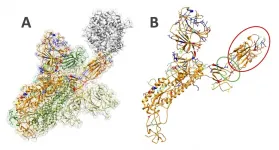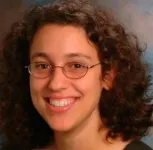Providing inclusive care for LGBTQ2SPIA+ cancer patients
A research article in the Journal of Medical Imaging and Radiation Sciences examines reducing barriers in the cancer-care trajectory for LGBTQ2SPIA+ patients
2021-02-02
(Press-News.org) Oxford, February 2, 2021 - In an upcoming issue of the Journal of Medical Imaging and Radiation Sciences, published by Elsevier, undergraduate researchers from the University of Alberta's Radiation Therapy Program in the Faculty of Medicine and Dentistry describe how LGBTQ2SPIA+ patients face unique cancer risks, including fear of discrimination, higher incidence of certain cancer sites, and lower screening rates, resulting in more cancers detected at later stages.
"I understand that there are different gender pronouns, I do not understand them all."
To discover the knowledge, attitudes, and practice behaviors of the healthcare professionals treating these patients, the authors surveyed Radiation Therapists (RTs)--key members of the cancer treatment team who are responsible for planning and delivering radiation therapy. In addition to the highly technical aspects of the job, RTs explain procedures, answer questions, comfort patients, and provide emotional support during the treatment journey, making these professionals a natural point of education and support for LGBTQ2SPIA+ patients.
Results suggest there are knowledge gaps and inconsistencies when caring for this patient population. Over 70 percent of respondents were unfamiliar with all terms associated with LGBTQ2SPIA+, and the same percentage were unsure if specific resources were available for the LGBTQ2SPIA+ population at their cancer center. This uncertainty affects the care given to these patients, either limiting RT's interactions with this community or being unable to provide specific side effect management education, a crucial part of the RT role.
Despite clear evidence of the RT community desiring LGBTQ2SPIA+-specific care, a significant portion of respondents stated that all patients should be treated equally, and therefore no practice adaptation is required. Most respondents reported being comfortable caring for the LGBTQ2SPIA+ community, despite the majority also asserting that they have had inadequate education in this area.
However, the survey found an overall willingness to improve practice behaviors, with 86.9 percent of total respondents interested in receiving more education on this topic. As one respondent stated:
"I can't really think of 'how' I am actively creating a safe environment for disclosing their sexual orientation, nor do I know how to properly create that environment....I can definitely say that I am non-judgmental of their life choices if it comes up in conversation, etc., but I really don't know what more I should be doing, admittedly. Further training or information on how to better create a safe environment for patients would be beneficial."
The authors conclude that future research should examine the experiences of LGBTQ2SPIA+ patients from their perspective. To provide truly patient-centered care, LGBTQ2SPIA+-targeted resources for both patients and radiation therapists need to be considered a priority.
INFORMATION:
[Attachments] See images for this press release:

ELSE PRESS RELEASES FROM THIS DATE:
2021-02-02
Beaten ballots: political participation dynamics amidst police interventions is the title of the academic article by Toni Rodon and Marc Guinjoan, lecturers of Political Sciences at UPF and the UB, respectively, which seeks to look in greater depth at the effects of police interventions regarding political participation, taking the "repression-mobilization" nexus debate as a starting point.
The study, published recently in the Cambridge University Press journal Political Science Research and Methods, focuses on the analysis of the referendum on independence held in Catalonia on 1 October 2017, when despite the police crackdown, 2,286,217 people voted, representing 44% of ...
2021-02-02
Experts predict that autonomous vehicles (AVs) will eventually make our roads safer since the majority of accidents are caused by human error. However, it may be some time before people are ready to put their trust in a self-driving car.
A new study in the journal Risk Analysis found that people are more likely to blame a vehicle's automation system and its manufacturer than its human driver when a crash occurs.
Semi-autonomous vehicles (semi-AVs), which allow humans to supervise the driving and take control of the vehicle, are already on the ...
2021-02-02
Recent global calamities - the pandemic, wildfires, floods - are spurring interdisciplinary scientists to nudge aside the fashionable First Law of Geography that dictates "everything is related to everything else, but near things are more related than distant things."
Geography, and by association, ecology, has largely followed what's known as Tobler's Law, which took hold in the early 1970s. But then came the novel coronavirus apparently has leapt from wildlife meat markets in China to the world in a matter of months. Global climate change creates conditions ripe for infernos in the North American west and Australia. ...
2021-02-02
EL PASO, Texas - An effort led by Lin Li, Ph.D., assistant professor of physics at The University of Texas at El Paso, in collaboration with students and faculty from Howard University, has identified key variants that help explain the differences between the viruses that cause COVID-19 and Severe Acute Respiratory Syndrome (SARS).
A team comprised of researchers from UTEP and the historically Black research university in Washington, D.C., discovered valuable data in comparing the fundamental mechanisms of Severe Acute Respiratory Syndrome Coronavirus (SARS-CoV) and SARS-CoV-2 -- also known as COVID-19 -- to better understand how ...
2021-02-02
CORVALLIS, Ore. - Extensive sea ice covered the world's oceans during the last ice age, which prevented oxygen from penetrating into the deep ocean waters, complicating the relationship between oxygen and carbon, a new study has found.
"The sea ice is effectively like a closed window for the ocean," said Andreas Schmittner, a climate scientist at Oregon State University and co-author on the paper. "The closed window keeps fresh air out; the sea ice acted as a barrier to keep oxygen from entering the ocean, like stale air in a room full of people. If you open the window, oxygen ...
2021-02-02
Amazon's search algorithm gives preferential treatment to books that promote false claims about vaccines, according to research by UW Information School Ph.D. student Prerna Juneja and Assistant Professor Tanu Mitra.
Meanwhile, books that debunk health misinformation appear lower in Amazon's search results, where they are less likely to be seen, the researchers wrote in a paper that was recently accepted to CHI, the top annual conference on human-computer interaction.
In their paper, Juneja and Mitra noted that Amazon has faced criticism for not regulating health-related products on its platform. They conducted audits to determine how much health misinformation is present in Amazon's recommendations ...
2021-02-02
The lockdowns and reduced societal activity related to the COVID-19 pandemic affected emissions of pollutants in ways that slightly warmed the planet for several months last year, according to new research led by the National Center for Atmospheric Research (NCAR).
The counterintuitive finding highlights the influence of airborne particles, or aerosols, that block incoming sunlight. When emissions of aerosols dropped last spring, more of the Sun's warmth reached the planet, especially in heavily industrialized nations, such as the United States and Russia, that normally pump high amounts of aerosols into the atmosphere.
"There was a big decline in emissions from the most polluting industries, and that had immediate, short-term effects on temperatures," said ...
2021-02-02
Yale researchers are developing a skin cancer treatment that involves injecting nanoparticles into the tumor, killing cancer cells with a two-pronged approach, as a potential alternative to surgery.
The results are published in the Proceedings of the National Academy of Sciences.
"For a lot of patients, treating skin cancer is much more involved than it would be if there was a way to effectively treat them with a simple procedure like an injection," said Dr. Michael Girardi, professor and vice chair of dermatology at Yale School of Medicine and senior author of the study. "That's always been a holy grail in dermatology -- to find a simpler way to treat skin cancers such as basal cell carcinoma and squamous cell carcinoma."
For the treatment, tumors are injected ...
2021-02-02
A new study from scientists of the Max Planck Institute for Evolutionary Biology in Plön, Germany, and the Chinese Academy of Sciences in Beijing shows that the potential genetic burden of mutations arising from retrogenes is significantly greater than originally thought.
Genetic information is stored in DNA and transcribed as mRNA. The mRNA is usually translated into proteins. However, it has long been known that mRNA can also be reverse transcribed to DNA and integrated back into the genome. Such cases are referred to as retrogenes. In an article, a team from the Max Planck Institute for ...
2021-02-02
When different groups of people come into contact, what's the key to motivating advantaged racial groups to join historically disadvantaged racial minority groups to strive for racial equality and social justice? It's a complex conundrum studied for years by social scientists like Linda Tropp, professor of social psychology at the University of Massachusetts Amherst.
Her latest research, published in the International Journal of Intercultural Relations, tested and supported Tropp and colleagues' proposition that having open communication about group differences is a crucial pathway.
While greater contact between racial groups is typically associated with less ...
LAST 30 PRESS RELEASES:
[Press-News.org] Providing inclusive care for LGBTQ2SPIA+ cancer patients
A research article in the Journal of Medical Imaging and Radiation Sciences examines reducing barriers in the cancer-care trajectory for LGBTQ2SPIA+ patients



